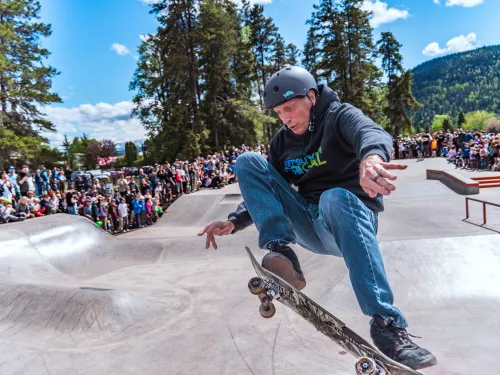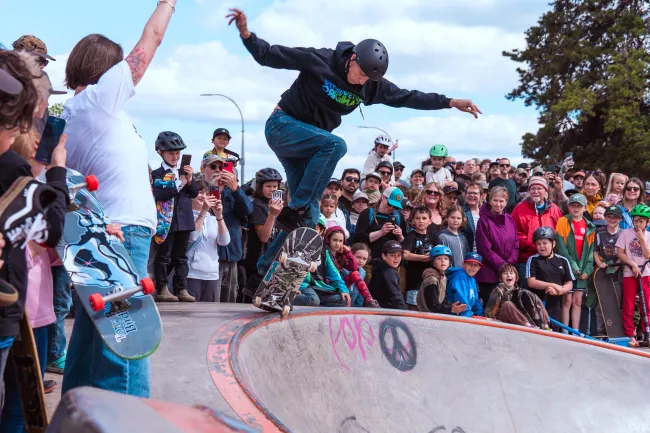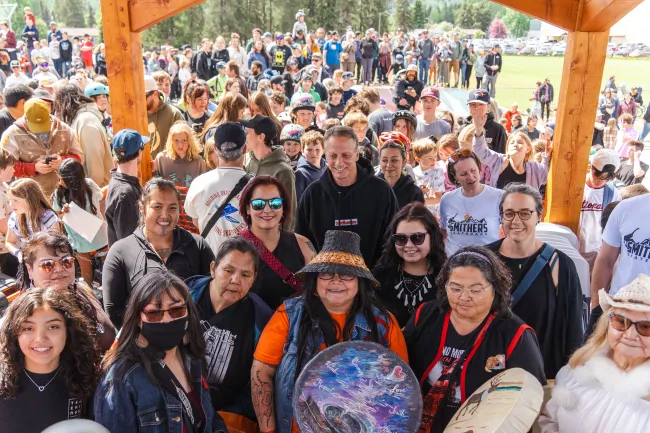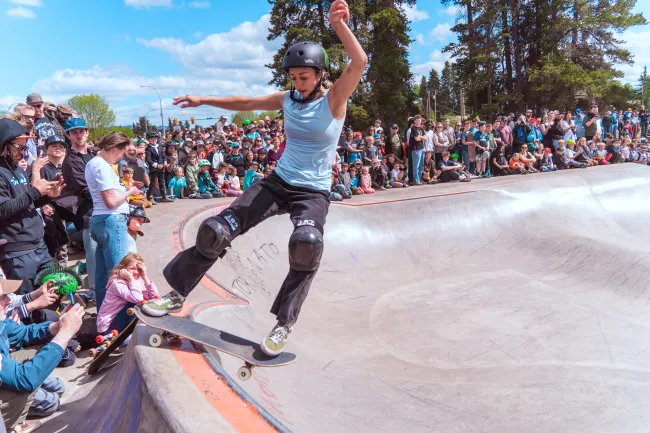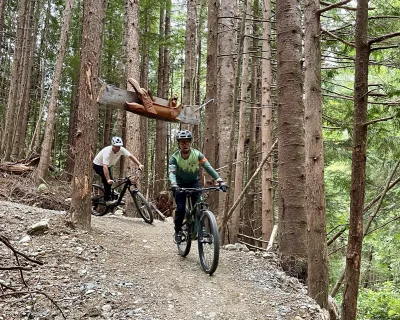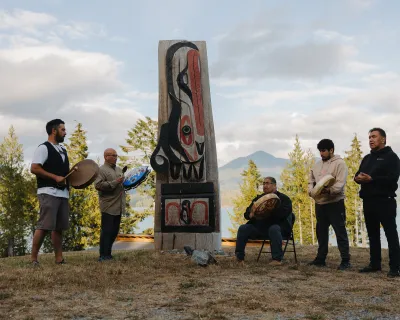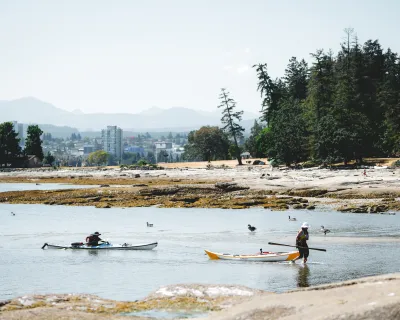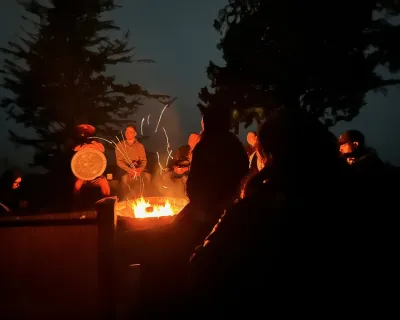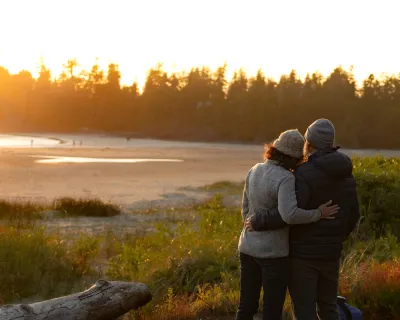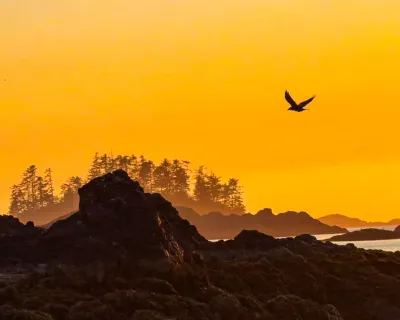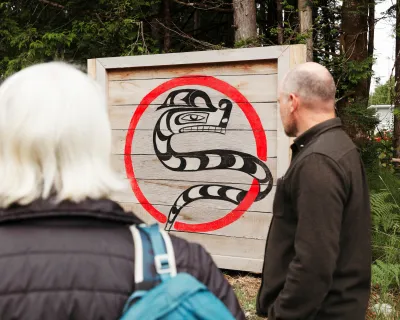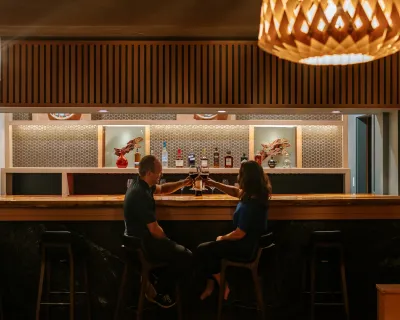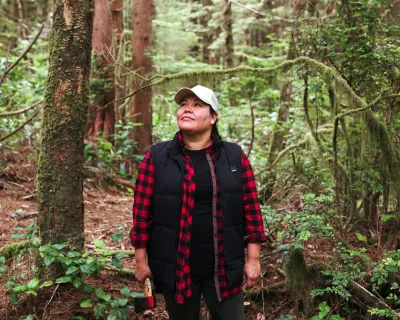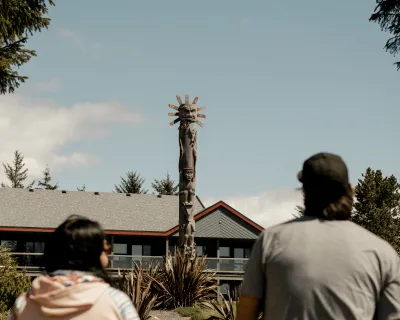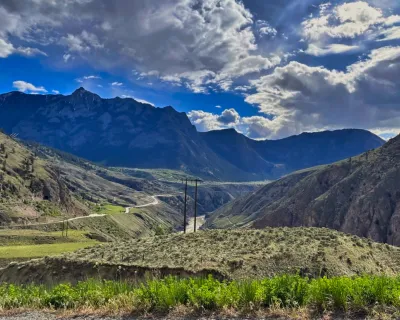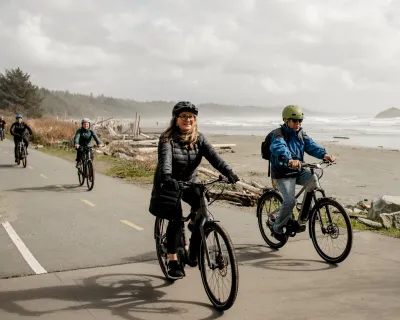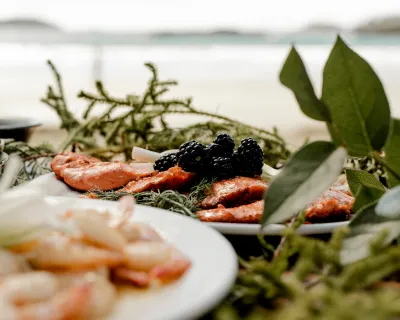The day Tony Hawk came to Smithers
Smithers, BC Tony Hawk is more than a professional skateboarder, he is a cultural icon. Much like Wayne Gretzky, Michael Jordan or Serena Williams redefined their sports, Tony Hawk revolutionized skateboarding. So when he came to the small northern BC town of Smithers, it was a galvanizing moment for local skaters and for the broader community, too.
Rising to fame in the 1980s, Tony Hawk pushed the boundaries of what was possible on a board. He went on to win dozens of competitions, launch one of the most successful video game franchises of all time, Tony Hawk’s Pro Skater, and create The Skatepark Project, helping fund hundreds of skateparks across North America.
Even if you don’t follow skateboarding, chances are you bought one of his video games or played them yourself. His impact stretches far beyond the skate world and continues to shape culture.
I grew up in the late ’80s and early ’90s, the era of VHS skateboarding tapes and Thrasher magazine. My brother used to buy Thrasher, and Tony Hawk was always front and center. Even though I wasn’t a skater, I spent hours on the Nintendo 64 playing Tony Hawk’s Pro Skater. For us, he wasn’t just a name. He was the name. So when word spread that Tony Hawk was coming to Smithers, it didn’t seem real.
I live and work in Witset, a Wet’suwet’en community about 32 km west of Smithers. It’s where I grew up and where I still call home. My mom is Wet’suwet’en, and my dad is white, so I grew up with a foot in two worlds. That mix has shaped how I see things, sometimes from the inside, sometimes like an observer.
While Smithers isn’t technically our hometown, we call it that because for many of us in surrounding communities, it’s the hub. It’s where we go for school, groceries, sports, hospital visits, and more. On May 29, 2025, this little mountain town became the center of the skateboarding world.
Tony Hawk dropped into the newly expanded Smithers Skate Park, along with Canadian snowboard legend Mark McMorris, the creative Grayson Fletcher, and the fearless Lizzie Armanto. But this wasn’t just a celebrity visit. It was a celebration of youth, community, and everything people in this region have built together.
The Smithers Skate Park has been around since 1996. Over time, it served countless youth but was showing its age. Thanks to the Smithers Skate Park Society, the Town of Smithers, and the Power To Give Foundation, it underwent a major expansion that wrapped up in 2025. It now features a new street section, an eight-foot bowl, lights, shaded seating, a water station, and landscaping. What was once a modest setup is now a world-class facility.
The event began with a powerful welcome from Ewh Hiyah Hozdli, a Wet’suwet’en drum group. Tony and his team were welcomed onto Gitdumden territory, part of the unceded lands of the Wet’suwet’en people. Their songs boomed through the air, grounding the moment in culture and territory.
I was on stage, just an arm’s length from Tony and the drummers. I could see on his face how much it meant. This wasn’t a performance. It was a shared moment between hosts and guests.
Later, Mark McMorris spoke about how skateboarding shaped him before snowboarding. He emphasized how spaces like this give youth an outlet, a place to belong, and a way to build confidence.
I was photographing the event on my day off, not on assignment, just as someone who didn’t want to miss a moment. I work as the Communications Manager for Witset First Nation, and I’m used to documenting meaningful stories. But this one felt different.
The energy at the park took me back. Back to when, if something was happening in Smithers, people showed up. That feeling returned. Families, elders, kids, and teens all came out. There were no divides or distractions. Just shared joy. For a few hours, strangers became neighbours.
While the event was happening, I kept having flashbacks. I was tripped out by memories of Tony Hawk posters and my brother’s old skate magazines. Every time Tony flew out of the bowl and landed a trick near my face, it felt surreal. He was inches from my lens. I even said out loud, “Never thought I’d photograph Tony Hawk… in Smithers.”
The same guy who drew crowds back then managed to bring back that old school Smithers vibe. It felt like time folded in on itself for one perfect afternoon
Tony Hawk doesn’t usually attend park openings. I later learned Mark McMorris extended the invitation, supported by the McMorris Foundation and Tim Cormode of the Power To Give Foundation. What they brought wasn’t just skill. It was a thank-you and a once-in-a-lifetime moment.
There are still some finishing touches to come, like signage and more shaded seating. But the real foundation is already here: the people, the spirit, the pride. This park is no longer just concrete and rails. It’s a symbol of what happens when a community believes in itself.
May 29, 2025, will be remembered as the day Tony Hawk came to Smithers. But more than that, it will be remembered as the day a small town and the communities around it came together to celebrate who they are and what they can become.
Smithers reminded us that greatness doesn’t need a big stage. It just needs people who care and a reason to gather.
find YOUR zen
Sign up for ZenSeekers enews for local culture & outdoor adventure across Western Canada.
I’ve seen Smithers go through a lot. There were good times and hard ones. Like many rural communities, we’ve faced challenges around cross-cultural understanding and belonging. Discrimination has left scars. But so have years of effort and healing.
That day gave me hope. People were sharing space, celebrating together, and showing that community doesn’t mean being the same. It means choosing to come together.
As I moved through the crowd with my camera, I kept hearing, “I want to try skateboarding.”
It was kids, teens, even parents. At one point, I overheard a young girl tell her family she wanted to try it after watching Lizzie Armanto. That kind of inspiration can’t be measured, but it was everywhere.
Events like this bridge gaps. They show us what’s possible when we celebrate differences. That day reminded us what community can look like and what it can become.
I know I might be making this out to be more than it was. But the truth is, it was more than just a skateboard event. Yes, it was a day at the park. But the ripple effects were powerful. The energy and excitement lit people up. So many good things happened as a result. Sometimes, what seems small on paper means the most in real life.
About the Writer
Dale Cutler is a proud Wet'suwet'en adventurer with a deep love for the Pacific Northwest. You can find him on a back road or a mountain, always looking for a cool shot. He spends his days chasing light, fresh air, and quiet places. You can find him at @dalecutler2 on Instagram.
